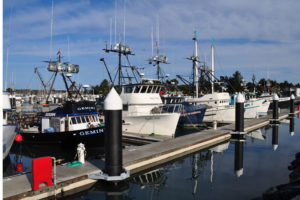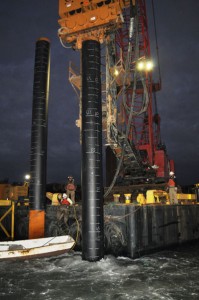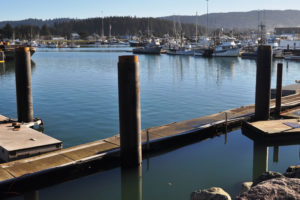 Crescent City (CA) Harbor’s Inner Boat Basin had been totally destroyed by the tsunami that struck the harbor on March 11, 2011 and was some of the most visible damage on this side of the Pacific during that tragedy.
Crescent City (CA) Harbor’s Inner Boat Basin had been totally destroyed by the tsunami that struck the harbor on March 11, 2011 and was some of the most visible damage on this side of the Pacific during that tragedy.
But he Crescent City Harbor District didn’t just set out to rebuild it, they made sure another tsunami wouldn’t do the same thing again. It’s taken three years to rebuild.
The new Inner Boat Basin (IBB) was dedicated at the Crescent City Harbor District on March 22. The new facility has 234 slips ranging in size from 30 to 70 feet with side-tie space for vessels up to 125 feet.
The new IBB was designed to resist a 50 year tsunami event. Stover Engineering, in association with Ben C. Gerwick, Inc., Kennedy/Jenks Consultants and Treadwell and Rollo Geotechnical collaborated on the Crescent City Harbor District Inner Boat Basin Reconstruction.
In 2010, coastal engineers from Ben C Gerwick, Inc., were tasked by Stover Engineering to determine hydrodynamic loads for the floating and fixed structures at the harbor. They studied past events, like the 2006 tsunami (literally translated as a “harbor wave” in Japanese) which was initiated by a magnitude 8.3 sub-sea earthquake in the Kuril Islands. The earthquake generated a 6.8 foot wave that reached the marina and created a destructive combination of strong surge and currents exceeding 13.8 mph that caused over $9.3 million in damages to the harbor.
Gerwick’s engineers used the BOUSS-2D model, which is a comprehensive numerical model based on a time-domain solution of a particular form of the Boussinesq equations. These equations are capable of describing highly asymmetric waves in shallow water, wave-induced currents, wave setup close to the shoreline and wave-current interaction.

Th difference in piling size is apparent.
The accuracy of their modeling was proven when the March 2011 tsunami destroyed the harbor in the manner in which they had projected.
The new IBB was constructed at a cost of over $34 million.
Thirty inch diameter pipe piles replaced the 12 to 16 inch diameter piles destroyed by the tsunami.
The massive new piles were driven from 21 to 37 feet to imbed them in the harbor bedrock.
The massive new piles were driven from 21 to 37 feet to imbed them in the harbor bedrock. The depth depended upon the location of the pile relative to the tsunami currents – lateral load – and the strength of the rock. The piles were designed to have a lateral load capacity at least 25% greater than the designed tsunami load to preclude failure of the piles and the necessity to replace piles into bedrock.
The prior piles were drilled 5 feet into the bedrock and impact driven an additional 5 feet after that.
The new piles have an inside closure plate at the top to create a dead air space within the pile. The piles are enclosed in a 34 inch outside diameter HDPE sleeve with a 1.6 inch wall thickness. The HDPE sleeves are intended to act as corrosion and abrasion protection.
Docks “A” through “G” were designed and manufactured by Bellingham Marine. The floating dock system is referred to as the Unibolt System. The fingers and headwalks have a concrete deck and concrete sides supported by Styrofoam trapped within the channel.
“H” dock is designed as a wave and current attenuator with many closely spaced piles to disrupt tsunami flow patterns within the harbor.
Prior to the tsunami, seafood landings in Crescent City were second only to San Francisco in Northern California. Currently there are around eighty commercial fishing vessels berthed at the marina. Dungeness crab, rockfish, and shrimp are major fisheries for the Crescent City fleet. Tuna are landed in Crescent City in the season when the schools venture closer to shore.
The Harbor District is trying to attract former tenants of the marina and would like to invite transient vessels to try the improved facilities, which include new ADA compliant restrooms, showers, laundry facilities and enclosed fish cleaning stations. Englund Marine has a store at the harbor and four restaurants are located on harbor property.
The Harbor operates a 30 ton Travelift and Fashion Blacksmith, the shipyard located at the Harbor, has a 100’ by 34’ Syncrolift shiplift platform with a 230 ton capacity.
The Harbor is only 8 miles from the Redwood National and State Parks where large groves of Coastal Redwoods still thrive.
For more information about the harbor, you can go to www.ccharbor.com


